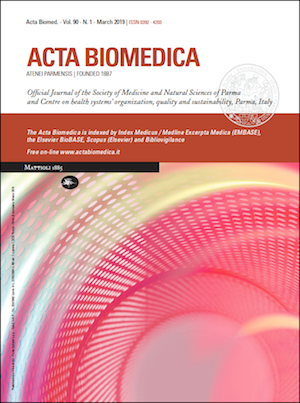Charcot-Marie-Tooth disease with pyramidal features due to a new mutation of EGR2 gene.
Keywords:
EGR2, Charcot-Marie-Tooth, CMT-1D, hereditary polyneuropathy, pediatric, sensory-motor neuropathyAbstract
Background and aim of the work: Childhood-onset peripheral neuropathies are often of genetic origin. Charcot-Marie-Tooth (CMT), is considered the commonest neuromuscular disorder. Due to its high clinical heterogeneity, especially in the pediatric age, the co-existence of central and peripheral symptoms and signs does not necessarily rule out a diagnosis of hereditary peripheral neuropathy. Methods: We describe the clinical, neurophysiological and genetic findings in a teen-age patient evaluated for acquired toe-walking and progressive difficulties in walking since the age of 5. Genetic testing was carried out with a targeted NGS panel. Identified variants are analyzed using Variant Studio program (Illumina). Rare variants and variants considered as pathogenic were analyzed by Sanger direct sequencing. Results: The coexistence of peripheral and pyramidal signs in the lower limbs, the absence of a significant pre/perinatal history, the unremarkable brain and spine MRI, together with the presence of a sensory-motor polyneuropathy in all four limbs, prompted the execution of genetic investigations with an NGS panel covering hereditary spastic paraplegias, motor neuron disease and Charcot-Marie-Tooth. We identified a previously undescribed variant (c.1142G>T, p.Arg381Leu) in the EGR2 gene. Conclusions: ERG2 gene has been described as a cause of various phenotypes, including a rare autosomal dominant form of CMT (CMT type 1D) representing approximately 1% of all CMT subgroups. We describe a novel pathogenic variant in EGR2 gene leading to the development of a complex association of peripheral and central neurological signs, underscoring the genetic and clinical heterogeneity of hereditary neuropathies of pediatric onset.
Downloads
Published
Issue
Section
License
This is an Open Access article distributed under the terms of the Creative Commons Attribution License (https://creativecommons.org/licenses/by-nc/4.0) which permits unrestricted use, distribution, and reproduction in any medium, provided the original work is properly cited.
Transfer of Copyright and Permission to Reproduce Parts of Published Papers.
Authors retain the copyright for their published work. No formal permission will be required to reproduce parts (tables or illustrations) of published papers, provided the source is quoted appropriately and reproduction has no commercial intent. Reproductions with commercial intent will require written permission and payment of royalties.







